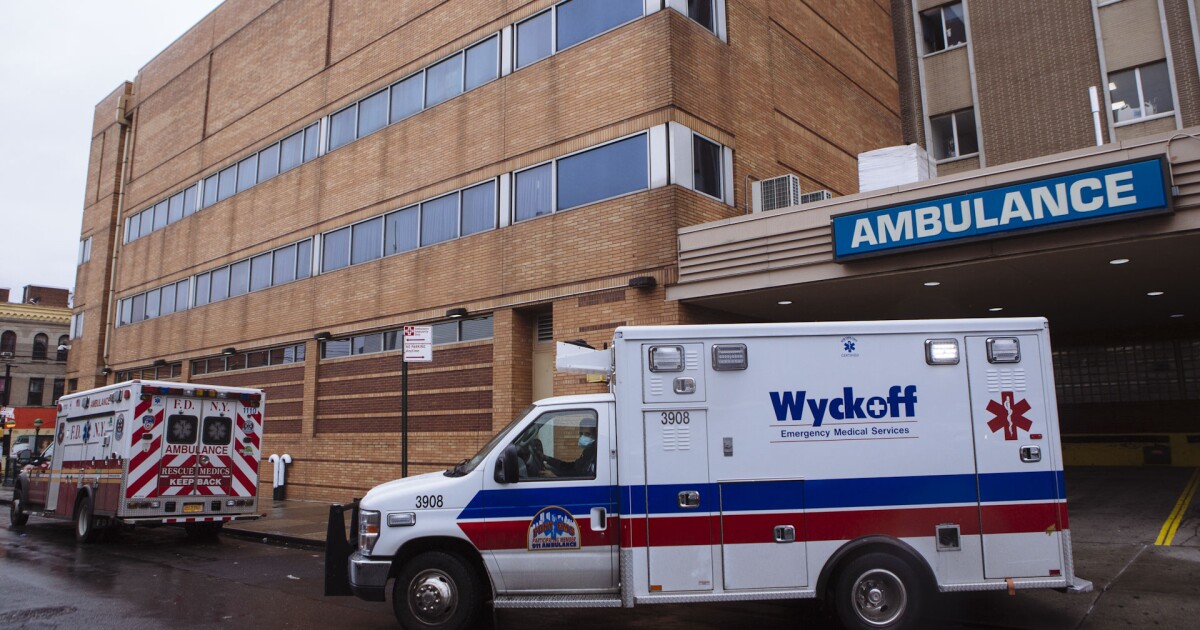New York State grapples with cuts to Medicaid in Republican tax bill
6 min read

Bloomberg News
When New York Gov. Kathy Hochul announced the state’s fiscal 2026 budget — way back in April — the impending Medicaid cuts in the Republican reconciliation bill were still taking shape, more of a vague threat on the horizon than a done deal.
Cutting Medicaid would have such enormous ramifications that state Director of Operations Kathryn Garcia questioned whether it would be politically feasible at all.
“The real driver of [Medicaid costs] is people using Medicaid. So if you are going to cut Medicaid, you are cutting the eligibility of people,”
Every member of the New York Republican delegation voted for The One Big Beautiful Bill Act, which is expected to cost New York and its healthcare systems $13 billion every year. It’s a figure far too large for the state to fill.
The new Medicaid policies don’t just mean people losing healthcare coverage. Stakeholders expect staggering administrative costs for the state, damage to local economies, and hospitals cutting services or shuttering altogether.
The OBBBA has a variety of provisions that will decrease Medicaid enrollment and shift costs to states, according to Fitch Ratings analyst Tammy Gamerman. Most of those policies will phase in over a period of four years, with no impact to states this year.
New York is the exception, Gamerman said.
New York projects that the OBBBA will cost the state $750 million in the current fiscal year, which will increase to $2.7 billion in fiscal year 2027.
A court ruling from 2001 mandates that New York provide healthcare for legal immigrants who have not resided in the country long enough to qualify for Medicaid, Gamerman said. There are currently 730,000 people in this category, and they’ve been receiving coverage through the Essential Plan, which is mostly federally funded.
At the end of August, many immigrants will no longer qualify for Essential Plan coverage, and New York will have to cover them through the state Medicaid program, using entirely state funds.
New York has the funds to cover those costs this year, Gamerman said; the state’s reserves, general fund balance, and tax returns are all very strong.
That’s just the first impact to New York’s budget. The new rules for Medicaid eligibility — work requirements, eligibility checks twice a year instead of once, requirements for states to verify enrollees’ addresses and social security numbers — will create costly administrative burdens for states.
Hochul estimated earlier this year that keeping up with the administrative requirements will cost
In early June, when the OBBBA had just passed the House of Representatives and New York was still investigating its implications, Budget Director Blake G. Washington emphasized that the state’s $254 billion budget left no leeway to backfill the $13 billion of federal cuts.
The fallout will affect more than just the one in three New Yorkers enrolled in Medicaid, Washington added.
“When you start to get these cuts of this magnitude, those cuts don’t just remain in a silo in the Medicaid bucket,” Washington said. “Those cuts start to permeate the state budget. And they creep into every other major item of spending in the state budget.”
Much of the $13 billion New York will lose won’t create new costs for the state Gamerman said. But as people lose healthcare coverage and hospitals struggle, the pressure to offset the losses will grow.
“That is a decision for the future, for the state legislature and the governor to talk about,” Gamerman said. “States don’t have to backfill the losses, but there will certainly be pressure down the road for them to do something.”
In order to meet the state’s new needs, Washington said, lawmakers may have to deprioritize social spending like education or childcare. The state will also have to “revisit what we’ve just passed in the state budget,” he said.
“We’re also going to have to engage the legislature to provide for restraint in our state spending,” Washington said. That includes “modifying the appropriations and what our obligations are into the future. That’s changing policies. It’s also reducing spending.”
New York’s hospitals are grappling with their own choices.
Healthcare systems weren’t flush with cash to begin with, according to Cristina Freyre Batt, senior vice president of federal policy at the Healthcare Association of New York State.
A survey from HANYS last year found that three quarters of New York’s hospitals had “unsustainable” operating margins of 3% or lower. Half of them had negative operating margins.
The state’s healthcare system has a few other quirks, according to Batt. Its hospitals are entirely nonprofit and their facilities are, on average, older than any other state’s in the country.
New York has many big healthcare networks that are sophisticated, profitable issuers, according to Fitch analyst Kevin Holloran. But the state also has both rural and urban hospitals with high concentrations of Medicaid recipients, some of whom are guaranteed to lose coverage under the OBBBA.
When patients lose coverage, they delay seeking healthcare until it’s absolutely necessary and they end up in the emergency room, Batt said. Emergency rooms are required to treat those patients whether they can pay or not. These cases are known as “uncompensated costs,” and under the OBBBA, New York hospitals’ uncompensated costs are expected to exceed $3 billion every year.
Most of the other changes will cost hospitals, too. Moving 700,000 people from the Essential Plan onto the state Medicaid program will mean lower reimbursement rates for providers. HANYS expects that to be a $1.8 billion impact to hospitals annually.
The OBBBA
Batt said the state may pass some of its new administrative costs onto providers as well.
In 2025, Holloran said, Fitch projects hospitals will have a “pretty good year.” In 2026 and 2027, as the new rules take effect, there will undoubtedly be a negative impact on hospital margins.
The uncompensated costs are likely to hit almost immediately after the new eligibility requirements take effect, Holloran said.
Many healthcare providers are taking action now to get ahead of future budget troubles, Batt said. They’re planning for layoffs and scrapping plans for capital projects.
An analysis from HANYS and the Greater New York Hospital Association projects 34,000 lost hospital jobs as a result of the OBBBA, which will cause 29,000 more lost jobs in their surrounding communities.
Hospitals will do everything they can to stay open, Batt and Holloran agreed. That includes shutting down less profitable services, like psychiatric and maternal care. Then, Holloran said, they may search for partnerships to stay afloat, or even shut down their emergency rooms altogether and operate on an outpatient basis.
Eventually, if the projections for the loss of Medicaid coverage are accurate, hospitals with a high percentage of Medicaid enrollees will likely close, Holloran said.
According to Washington, New York’s economic signals are already “not wonderful.” New York’s economy is sensitive to the economic volatility in national and global markets. Economic volatility combined with new federal cuts and costs, Washington said, create a “double whammy” for the state’s economy.
Holloran had one optimistic suggestion: the loss of coverage may not be as high as projections suggest.
When the Affordable Care Act first passed, analysts were absolutely certain that employers would drop their employees off of their healthcare plans and leave them to purchase healthcare themselves on the exchanges, Holloran said.
“You may find, a year and a half from now, when all of this stuff is put into play, that people go through and meet the work requirements, that they will jump through any hurdle to maintain that coverage, because they’ve got a real serious illness, or a family member who is ill, or something along those lines,” Holloran said. “It is hard to predict human behavior on what you will or won’t do to maintain coverage.”







